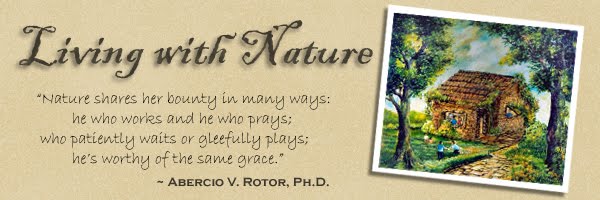Global Warming is accelerating!
Ninety-seven percent of climate scientists agree that climate-warming trends over the past century are very likely due to human activity since the mid-20th century.
Dr Abe V Rotor
Former Professor, UST, DLSU-D Lesson in Advanced Ecology UST and DLSU(D) Graduate Schools. How can an ordinary citizen help in cushioning global warming.
Sign of the Times: Smog, acid rain and ozone depletion rolled altogether.
Photo by AVR Fairview, QC 2010
Acknowledgment: Time Magazine
Here are scientific evidences released by the
Intergovernmental Panel on Climate Change
It is a fact that the Earth's climate has been changing throughout history. In the last 650,000 years there have been seven cycles of glacial advance and retreat, with the abrupt end of the last ice age about 7,000 years ago marking the beginning of the modern climate era — and of human civilization.
The planet's average surface temperature has risen about 1.62 degrees Fahrenheit (0.9 degrees Celsius) since the late 19th century, with most of the warming occurring in the past 35 years with the five warmest years on record taking place since 2010. The warmest year on record was 2016. The IPCC report continues with these alarming developments:
The oceans are getting warmer.
Ice sheets are shrinking, especially Greenland and Antarctic. The Arctic sea ice is declining.
Glaciers are retreating almost everywhere around the world — including in the Alps, Himalayas, Andes, Rockies, Alaska and Africa (Mount Kilimanjaro),.
The snow cover in the Northern Hemisphere is melting at an earlier rate. .
Sea level is rising. Global sea level rose about 8 inches in the last century. The rate in the last two decades, however, is nearly double that of the last century and is accelerating slightly every year.
Extreme events such as extreme temperature, intense rainfall, and other force majeure
The acidity of surface ocean waters has increased by about 30 percent since the beginning of the Industrial Revolution
This global scenario calls for an urgent collective action. It is a plea addressed to governments, organizations, individuals all over the world> It is a plea beyond message of an Internationally famous broadcaster, natural historian and author, David Attenborough. To wit:
"When we look at the rising ocean temperatures, rising carbon dioxide in the atmosphere and so on, we know that they are climbing far more steeply than can be accounted for by the natural oscillation of the weather … What people (must) do is to change their behavior and their attitudes … for our upcoming generation we have to do something, and we have to demand for government support
"Right now we are facing a man-made disaster of global scale, our greatest threat in thousands of years: climate change. If we don’t take action, the collapse of our civilizations and the extinction of much of the natural world is on the horizon".
- David Attenborough, 2018.~




































